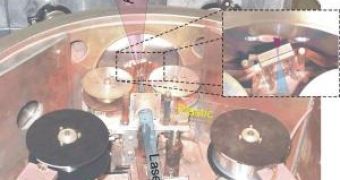Scientists demonstrated that ten thousand molecules can perform aligning pirouettes through a process known as ultrafast intramolecular electronic charge separation, appearing during photo-chemical reactions.
A study performed at the Max-Born-Institute for Nonlinear Optics and Ultrafast Spectroscopy and at the Ludwig-Maximilians-University in Munich proved that molecules can align their respective dipole axes along photoinduced electric fields.
To do this, the researchers initiated a separation of positive and negative electronic charge in a small number of particular molecules with extremely short light pulses, which cause the surrounding molecules to perform the alignment.
This is actually the first time such a fundamental process has been observed, in real time and with high spatial precision, using femtosecond x-ray diffraction. This phenomenon occurs in nature, where chemical and biochemical reactions are strongly influenced by the surroundings.
Water, for instance, is a good example of macromolecular environment where these alignments can take place. The structure of the surrounding environment can suffer considerable changes, which determine backwards the reaction speed and the stability of the reaction products, which can take even less than a millionth of a millionth of a second.
The scientists deduced the separation and orientation of molecules from x-ray pictures of groups of molecules, taken with the help of ultrafast x-ray pulses. They have successfully detected structural changes in the molecular surroundings with a precision of fractions of an atomic diameter.
What is the explanation for these molecular pirouettes? The charge separation that occurs in the photo-excited molecules generates electric field that effectively forces the surrounding molecules rotate up to angles of 10 degrees. Around ten thousands of surrounding molecules take part in this process, due to the distant action of electric fields.
This phenomenon will be further investigated by using laser-driven x-ray applications.

 14 DAY TRIAL //
14 DAY TRIAL //